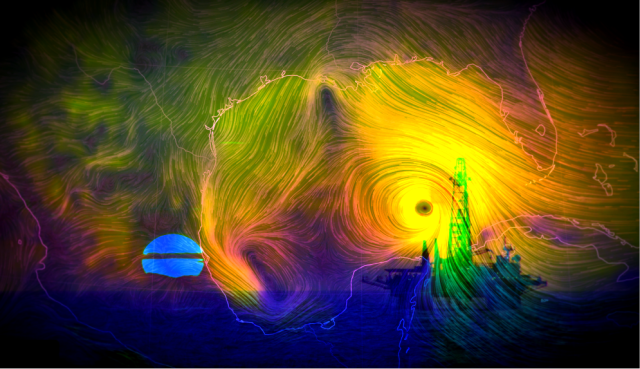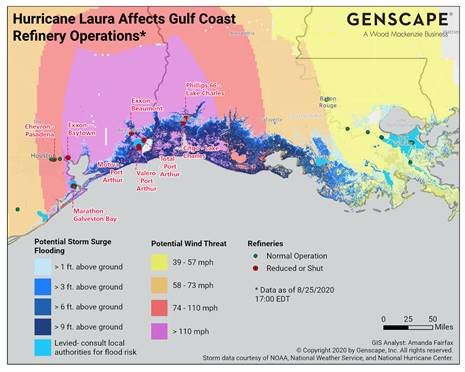
Simulation of Laura in the U.S. Gulf of Mexico on Aug. 25. (Source: earth.nullschool.net; Additional image courtesy of Shutterstock.com)
[Editor’s note: This story was updated at 5:11 p.m. CT Aug. 25. It was originally published at 10 a.m. CT.]
The U.S. energy industry on Aug. 25 was preparing for a major hurricane strike, cutting crude production at a rate approaching the level of 2005's Hurricane Katrina and halting oil refining at plants along the Texas-Louisiana coast.
Officials in the two states ordered hundreds of thousands of coastal residents to flee inland as Hurricane Laura strengthened and forecasters predicted it would become a major hurricane with sustained, 115 mile per hour (185 kph) winds.
At least a 10-ft (3-m) storm surge will likely hit the upper Texas coast later this week, said Chris Kerr, a meteorologist at agriculture, energy and weather data provider DTN. He said rapid intensification could even produce a devastating Category 4 hurricane.
Oil producers on Aug. 25 had evacuated 310 offshore facilities and shut 1.56 million bbl/d of crude output, 84% of Gulf of Mexico's offshore production, near the 90% outage that Katrina brought 15 years ago.
RELATED:
Stronger Hurricane Laura Takes Aim at Heart of US Oil Refining Industry
Twin US Gulf Coast Storms Stir Deep Production Cuts by Energy Giants
The storm will make landfall by early Aug. 27 in an area that accounts for more than 45% of total U.S. petroleum refining capacity and 17% of oil production, according to the Energy Information Administration.
Refiners that produce gasoline and diesel fuel were taking steps to halt nine facilities that process nearly 2.9 million bbl/d of oil, 14.6% of the U.S. total capacity, according to Reuters tallies.
The impact on refineries so far is less than Hurricane Harvey, whose drenching rains took down nearly one quarter of U.S. refining capacity three years ago.

U.S. gasoline futures have jumped as much as 10% since Aug. 21, while crude benchmarks settled at a five-month high on Aug. 25 due to the shutdowns.
"There will be a significant storm surge from Galveston (Texas) to the Sabine River," an area encompassing some of the region's largest refineries, said DTN's Kerr. "There are ideal conditions in central and west Gulf for rapid intensification."
Officials in Texas and Louisiana called for mandatory evacuations affecting half a million people. Residents from areas of Houston east to Orange, Texas, should flee the area and seek shelter inland, Texas officials said.
Cheniere Energy Inc., the largest U.S. exporter of LNG, evacuated staff and suspended operations at its Sabine Pass LNG export terminal on the Texas/Louisiana border.
Motiva Enterprises, Total SA and Valero Energy Corp. began cutting operations at their Port Arthur, Texas, refineries, according to people familiar with the matter.
Total, Motiva and Valero confirmed the shutdowns, and a Valero spokeswoman said it also was reviewing the risks to its Texas City, plant southeast of Houston.
Citgo Petroleum was halting operations at its 418,000 bbl/d refinery in Lake Charles, La., and Chevron Corp. shut gasoline production at its 112,000 bbl/d Pasadena, Texas, refinery, spokespeople said.
Exxon Mobil Corp. began shutting production at its large Beaumont, Texas, refinery and reduced output at its Baytown, Texas, plant ahead of a possible shutdown.
Exxon Mobil confirmed it was initiating a shutdown at Beaumont and was preparing for possible severe weather at its Baytown refinery and chemical complex, a spokesman said. If the Baytown plant fully halts processing, total shutdowns along the coast would hit 2.89 million bbl/d.
Marathon Petroleum declined to comment on the status of its 585,000 bbl/d plant in Texas City, the second largest refinery in the U.S. after Motiva's.
Recommended Reading
Range Resources Holds Production Steady in 1Q 2024
2024-04-24 - NGLs are providing a boost for Range Resources as the company waits for natural gas demand to rebound.
Hess Midstream Increases Class A Distribution
2024-04-24 - Hess Midstream has increased its quarterly distribution per Class A share by approximately 45% since the first quarter of 2021.
Baker Hughes Awarded Saudi Pipeline Technology Contract
2024-04-23 - Baker Hughes will supply centrifugal compressors for Saudi Arabia’s new pipeline system, which aims to increase gas distribution across the kingdom and reduce carbon emissions
PrairieSky Adds $6.4MM in Mannville Royalty Interests, Reduces Debt
2024-04-23 - PrairieSky Royalty said the acquisition was funded with excess earnings from the CA$83 million (US$60.75 million) generated from operations.
Equitrans Midstream Announces Quarterly Dividends
2024-04-23 - Equitrans' dividends will be paid on May 15 to all applicable ETRN shareholders of record at the close of business on May 7.





